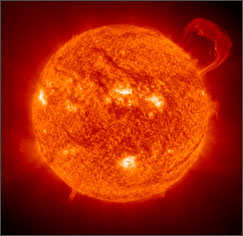
|
|
An
image of a huge prominence
taken by the NASA's
SOHO Mission |
|
|
Plasma,
Solar Wind, and Communications Disturbances
The Solar Probe is projected to launch in the next decade. Letís assume that the shield functions correctly and the spacecraft
is able to pass through the
Sunís corona or atmospheric layer. What then? What types of data will be collected?
How will it affect people on Earth? The Solar Probe will carry instruments to
measure the amount of plasma emitted by the Sun, as well as various magnetometers
(instruments that measure
changes in the Sunís magnetic field) and spectrometers (instruments that measure
the amount and wavelength of
light emitted by the Sun).
Definition: Solar wind is a stream of electrically
charged
gas flowing from the Sun's surface into space. The speed of
the wind can vary from 1 million to 2 million mph (1.5
million to 3 million kilometers an hour). Variations in the
wind can cause dramatic changes in the shape of Earth's
magnetic field and that, in turn, can damage satellites and
disrupt electronic communications. Various experiments
have been performed that show that the solar wind exists.
In one experiment, small pieces of metal foil were placed
on the Moon and were exposed to the solar wind. The
atoms from the wind that embedded themselves in the foil
were later analyzed on Earth.
The picture (left) shows the honeycomb-like
pattern of fissures in the Sunís surface that give rise to
solar wind.
This image was obtained by the SOHO (SOLAR AND
HELIOSPHERIC OBSERVATORY) satellite, a mission
jointly funded by NASA and the European Space Agency.
Don Hassler, a scientist at the Southwest Research Institute,
had this to say about solar wind:
ďPrimitive societies werenít affected by the solar wind
at all, but as we become more and more dependent on
advanced technology, we become more and more susceptible
to its effects. Who knows? In another 10-20 years,
we may be as concerned with the solar weather forecast
as we are with the local forecast!ď
Page 3 of 3 |
|
|




